Two-Phase Flow Visualization and Heat Transfer Characteristics Analysis in Ultra-Long Gravity Heat Pipe
Abstract
1. Introduction
2. Experimental System
2.1. Experimental Setup and Procedure
2.2. Uncertainty Analysis
- (1)
- Temperature measurement is performed using a Pt100 platinum resistance thermometer with a temperature range from 0 to 300 °C, with a maximum allowable measurement error of 0.3%. The uncertainty of the temperature measurement using a resistance thermometer is UT = 0.3%.
- (2)
- Pressure monitoring is accomplished using a ceramic capacitive pressure transmitter with an accuracy of 0.1% and a measuring range from 0 to 200 kPa. The uncertainty of the pressure measurement is Up = 0.1%.
- (3)
- The heating power Qin of the electric heating wire in the experiment is measured via a wattmeter, with an uncertainty of 0.4%; thus, the uncertainty of heating power UQin is 0.4%. Since the temperature of the heat pipe is higher than the ambient temperature during operation and heat is dissipated to the environment, the actual heat input to the heat pipe is the difference between the heating power of the electric heating wire and the heat dissipation of the heat pipe. The heating power mentioned in this article refers to the heating power of the electric heating wire.
- (4)
- The cooling water flow rate V is read from a flow meter, with an uncertainty of UV = 0.2%.
- (5)
- The heat transfer of the heat pipe is indirectly calculated using the heat received by the cooling water, which can be calculated based on the inlet and outlet temperatures of the cooling water, and the heat transfer is Qout = ρcpV(T30–T29), where cp and ρ are the specific heat capacity and density of the cooling water, respectively. The relative uncertainty of the heat quantity is UQout = [(UT)2 + (UV)2]−1/2 = 0.361%.
3. Result Analysis
3.1. The Heat Transfer Performance of Heat Pipe
3.2. Boiling Behavior of the Working Fluid in the Lower Part of the Heating Section
3.3. Two-Phase Flow Behavior in the Adiabatic Section
3.4. Limitations on the Heat Transfer Performance of Ultra-Long Gravity Heat Pipe
4. Conclusions
- (1)
- It is observed that the heat transfer capacity and heat transfer rate of the heat pipe increase firstly and then decrease with the increasing of the heating power. The optimal heat transfer performance was achieved at 162 W, with a heat transfer rate of 31%.
- (2)
- At low heating powers (200 W, 250 W), the heating section is well-wetted, but the evaporation rate is relatively low. The gas–liquid backflow in the adiabatic section is smooth. It is concluded that the main reason limiting the heat transfer performance of the heat pipe is the low evaporation rate of the working fluid in the heating section.
- (3)
- At a moderate heating power of 300 W, the evaporation rate in the heating section increases rapidly while remaining stable. Although liquid columns appear intermittently in the adiabatic section, the path of steam rising and condensate flowing back is unobstructed, and there is no blocking of condensate column in the condenser or drying phenomena in the heating section. Furthermore, even though the gas–liquid slugging causes certain counter-current resistance, it has not seriously affected steam condensation and reflux-evaporation. At this point, the temperature gradient along the heat pipe full length is small, leading to a better heat transfer efficiency and rate.
- (4)
- As the heating power continues to increase (350 W, 400 W), drying appears in the lower part of the heating section, and most of the condensate from the adiabatic section is carried to the condensation section by gas–liquid slugging. On the one hand, this hinders steam condensation in the condensation section, seriously affecting its heat transfer performance and resulting in sub-cooling. On the other hand, a large amount of condensate is trapped in the upper part of the adiabatic or even the condensation section, less liquid returns to the heating section causing the lower part of the heating section to be dry-out for a long time, the wall temperature of the heat pipe rises, and the heat transfer performance deteriorates. At this moment, the blockage of condensate column caused by the condensation of the gas–liquid mixture is the primary cause that restricts the heat transfer efficiency at a high heating power.
Author Contributions
Funding
Data Availability Statement
Conflicts of Interest
Nomenclature
| Qin | heat input of the heat section/W |
| Qout | heat output of the condenser section/W |
| ρ | density of coolant water/kg·m−3 |
| ρl | density of working fluid/kg·m−3 |
| cp | isobaric heat capacity/J·kg−1·K−1 |
| vc | mass flow rate of the coolant water/m·s−1 |
| Psat | saturation temperature/K |
| T | temperature/K |
| ∆h | distance from the liquid interface of the liquid pool/m |
| D | diameter/m |
References
- Jiang, F.; Huang, W.; Cao, W. Mining Hot Dry Rock Geothermal Energy by Heat Pipe: Conceptual De-sign and Technical Feasibility Study. Adv. New Renew. Energy 2017, 5, 426–434. [Google Scholar]
- Huang, W.; Cao, W.; Jiang, F. A novel single-well geothermal system for hot dry rock geothermal energy exploitation. Energy 2018, 162, 630–644. [Google Scholar] [CrossRef]
- Huang, W.; Cen, J.; Chen, J.; Cao, W.; Li, Z.; Li, F.; Jiang, F. Heat extraction from hot dry rock by super-long gravity heat pipe: A field test. Energy 2022, 247, 123492. [Google Scholar] [CrossRef]
- Huang, W.; Chen, J.; Cen, J.; Cao, W.; Li, Z.; Li, F.; Jiang, F. Heat extraction from hot dry rock by super-long gravity heat pipe: Effect of key parameters. Energy 2022, 248, 123527. [Google Scholar] [CrossRef]
- Kusaba, S.; Suzuki, H.; Hirowatari, K.; Mochizuki, M.; Mashiko, K.; Nguyen, T.; Akbarzadeh, A. Extraction of geothermal energy and electric power generation using a large scale heat pipe. In Proceedings of the World Geothermal Congress, Kyushu-Tohoku, Japan, 28 May–10 June 2000; pp. 3489–3494. [Google Scholar]
- Liu, H.; Wang, X.; Zheng, L.; Yao, H.; Zhu, Y.; Wang, Y. Temperature response and thermal performance analysis of a super-long flexible thermosy-phon for shallow geothermal utilization: Field test and numerical simulation. Int. J. Heat Mass Transf. 2022, 192, 122915. [Google Scholar] [CrossRef]
- Wang, X.; Yao, H.; Li, J.; Wang, Y.; Zhu, Y. Experimental and numerical investigation on heat transfer characteristics of ammonia ther-mosyhpons at shallow geothermal temperature. Int. J. Heat Mass Transf. 2019, 136, 1147–1159. [Google Scholar] [CrossRef]
- Reay, D.A.; Kew, P.A.; Mcglen, R.J. Chapter 2—Heat Transfer and Fluid Flow Theory. In Heat Pipes, 6th ed.; Reay, D.A., Kew, P.A., Mcglen, R.J., Eds.; Butterworth-Heinemann: Oxford, UK, 2014; pp. 15–64. [Google Scholar]
- Wenbo, H.; Wenjiong, C.; Tingliang, L.; Fangming, J. Numerical study and economic analysis of gravity heat pipe hot dry rock geothermal system. CIESC J. 2021, 72, 1302–1313. [Google Scholar]
- Moon, S.-H.; Park, Y.-W.; Yang, H.-M. A single unit cooling fins aluminum flat heat pipe for 100 W socket type COB LED lamp. Appl. Therm. Eng. 2017, 126, 1164–1169. [Google Scholar] [CrossRef]
- Tian, E.; He, Y.-L.; Tao, W.-Q. Research on a new type waste heat recovery gravity heat pipe exchanger. Appl. Energy 2017, 188, 586–594. [Google Scholar] [CrossRef]
- Wang, Y.; Wang, B.; Zhu, K.; Li, H.; He, W.; Liu, S. Energy saving potential of using heat pipes for CPU cooling. Appl. Therm. Eng. 2018, 143, 630–638. [Google Scholar] [CrossRef]
- Zeghari, K.; Louahlia, H.; Le Masson, S. Experimental investigation of flat porous heat pipe for cooling TV box electronic chips. Appl. Therm. Eng. 2019, 163, 114267. [Google Scholar] [CrossRef]
- Zhang, M.; Lai, Y.; Zhang, J.; Sun, Z. Numerical study on cooling characteristics of two-phase closed thermosyphon embankment in permafrost regions. Cold Reg. Sci. Technol. 2011, 65, 203–210. [Google Scholar] [CrossRef]
- Sbaity, A.A.; Louahlia, H.; Le Masson, S. Performance of a hybrid thermosyphon condenser for cooling a typical data center un-der various climatic constraints. Appl. Therm. Eng. 2022, 202, 117786. [Google Scholar] [CrossRef]
- Jasim, A.K.; Freegah, B.; Alhamdo, M.H. Numerical and experimental investigation of a thermosiphon solar water heater sys-tem thermal performance used in domestic applications. Heat Transf. 2021, 50, 4575–4594. [Google Scholar] [CrossRef]
- Ozbas, E. A novel design of passive cooler for PV with PCM and two-phase closed thermosyphons. Sol. Energy 2022, 245, 19–24. [Google Scholar] [CrossRef]
- Tong, Z.; Fang, C.X.; Zang, G.J.; Wu, H. Experimental study on the passive regulation of a CO2 two-phase thermosyphon loop. Appl. Therm. Eng. 2023, 219, 119457. [Google Scholar] [CrossRef]
- Lin, T.; Quan, X.J.; Cheng, P. Experimental investigation of superlong two-phase closed thermosyphons for geothermal utiliza-tion. Int. J. Therm. Sci. 2022, 171, 107199. [Google Scholar] [CrossRef]
- Hu, C.J.; Yu, D.L.; He, M.S.; Mei, H.P.; Yu, J.; Li, T.S. Performance evaluation of ultra-long lithium heat pipe using an improved lumped parameter model. Nucl. Sci. Tech. 2021, 32, 141. [Google Scholar] [CrossRef]
- Tingliang, L.; Jiwen, C.; Wenbo, H.; Fangming, J. Experimental study on heat transfer performance of super long gravity heat pipe. CIESC J. 2020, 71, 997–1008. [Google Scholar]
- Chen, J.; Cen, J.; Huang, W.; Jiang, F. Multiphase flow and heat transfer characteristics of an extra-long gravity-assisted heat pipe: An experimental study. Int. J. Heat Mass Transf. 2020, 164, 120564. [Google Scholar] [CrossRef]
- Wang, X.; Liu, H.; Wang, Y.; Zhu, Y. CFD simulation of dynamic heat transfer behaviors in super-long thermosyphons for shallow geothermal application. Appl. Therm. Eng. 2020, 174, 115295. [Google Scholar] [CrossRef]
- Wang, F.; Liu, X.; Jiang, B.; Zhuo, H.; Chen, W.; Chen, Y.; Li, X. Low-loading Pt nanoparticles combined with the atomically dispersed FeN4 sites supported by FeSA-N-C for improved activity and stability towards oxygen reduction reaction/hydrogen evolution reaction in acid and al-kaline media. J. Colloid Interface Sci. 2023, 635, 514–523. [Google Scholar] [CrossRef] [PubMed]
- Li, Q.; Wang, F.; Wang, Y.; Zhou, C.; Chen, J.; Forson, K.; Miao, R.; Su, Y.; Zhang, J. Effect of reservoir characteristics and chemicals on filtration property of water-based drilling fluid in unconventional reservoir and mechanism disclosure. Environ. Sci. Pollut. Res. 2023, 30, 55034–55043. [Google Scholar] [CrossRef] [PubMed]
- Li, Q.; Zhao, D.; Yin, J.; Zhou, X.; Li, Y.; Chi, P.; Han, Y.; Ansari, U.; Cheng, Y. Sediment Instability Caused by Gas Production from Hydrate-bearing Sediment in Northern South China Sea by Horizontal Wellbore: Evolution and Mechanism. Nat. Resour. Res. 2023, 1–26. [Google Scholar] [CrossRef]
- Sakamoto, Y.; Sato, T.; Kobayashi, H. Development study of a capacitance void fraction sensor using asymmetrical electrode plates. J. Fluid Sci. Technol. 2016, 11, JFST0008. [Google Scholar] [CrossRef]
- Hewlin, R.L.; Kizito, J.P. Development of a Capacitance Based Void Fraction Sensor for Two-Phase Flow Measurements. In Fluids Engineering Division Summer Meeting; American Society of Mechanical Engineers: New York, NY, USA, 2013; Volume 55584, p. V002T11A005. [Google Scholar] [CrossRef]

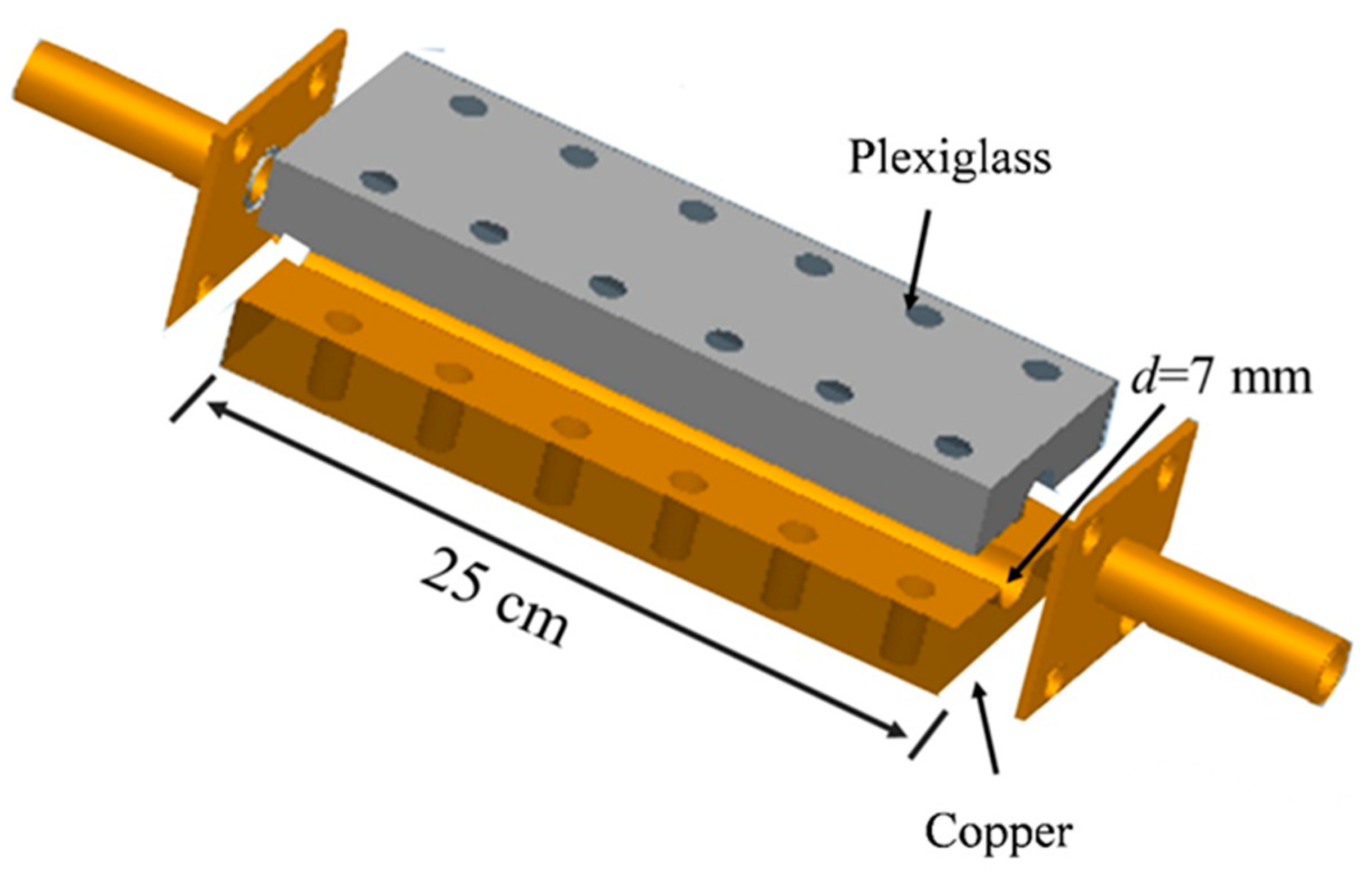
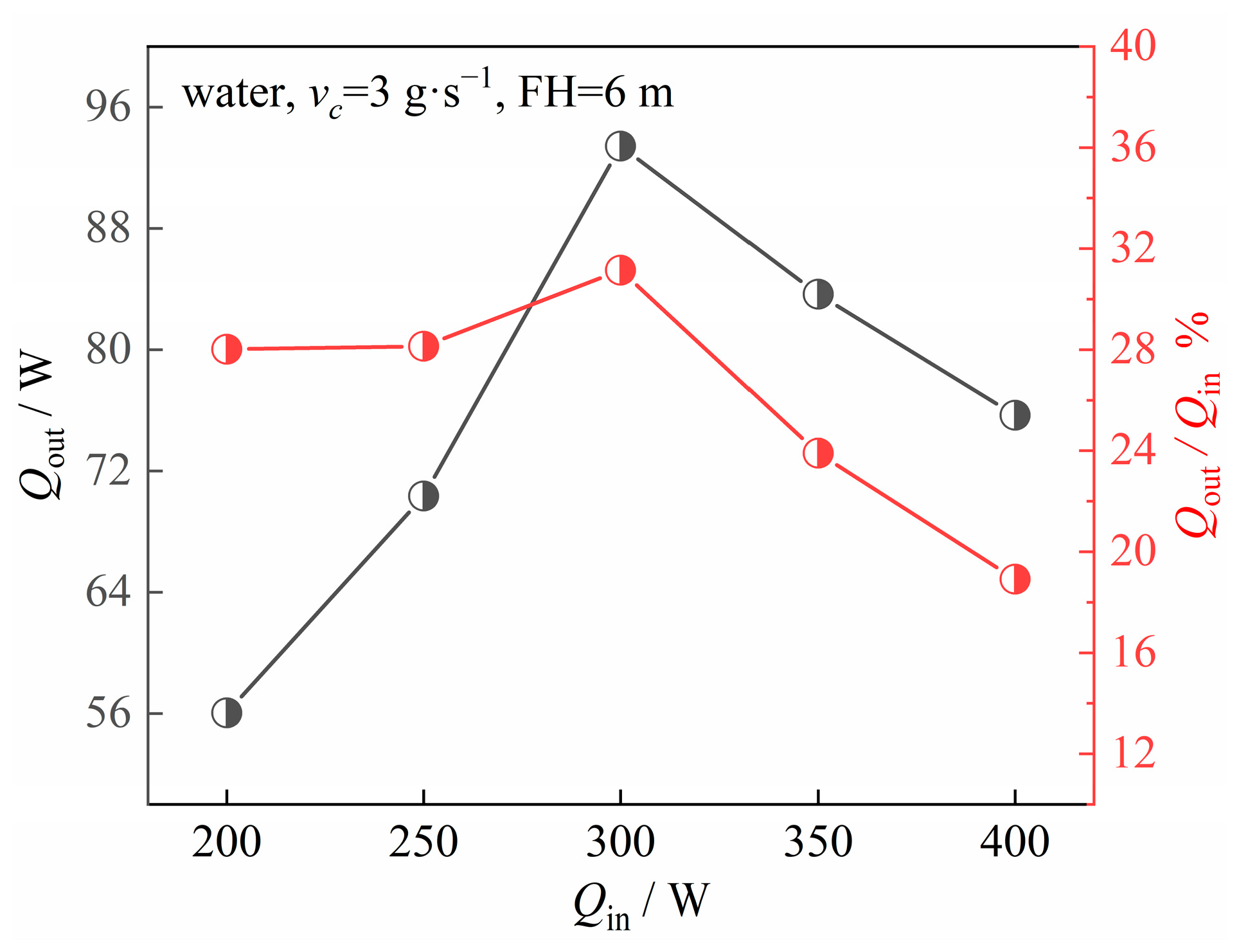
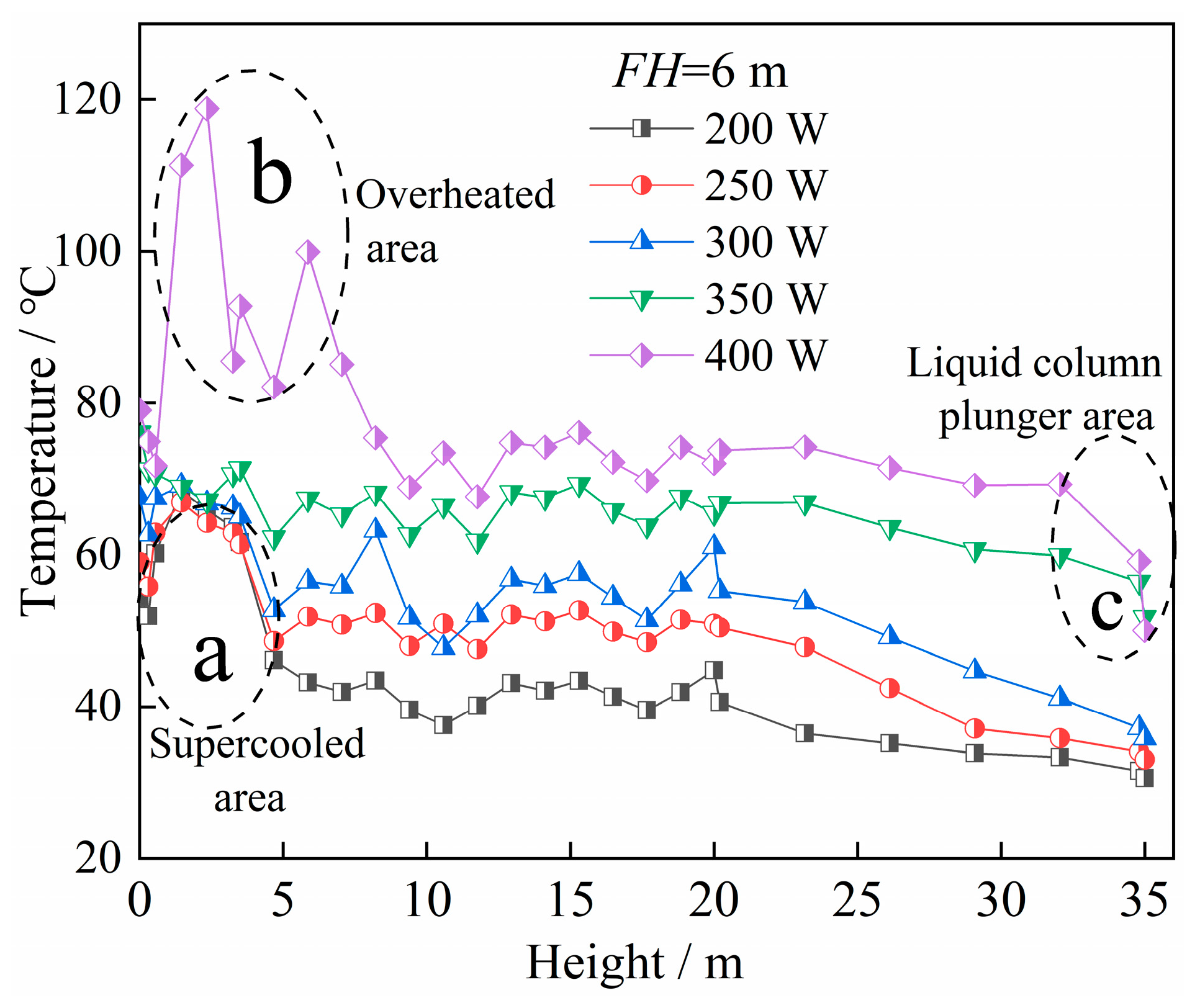
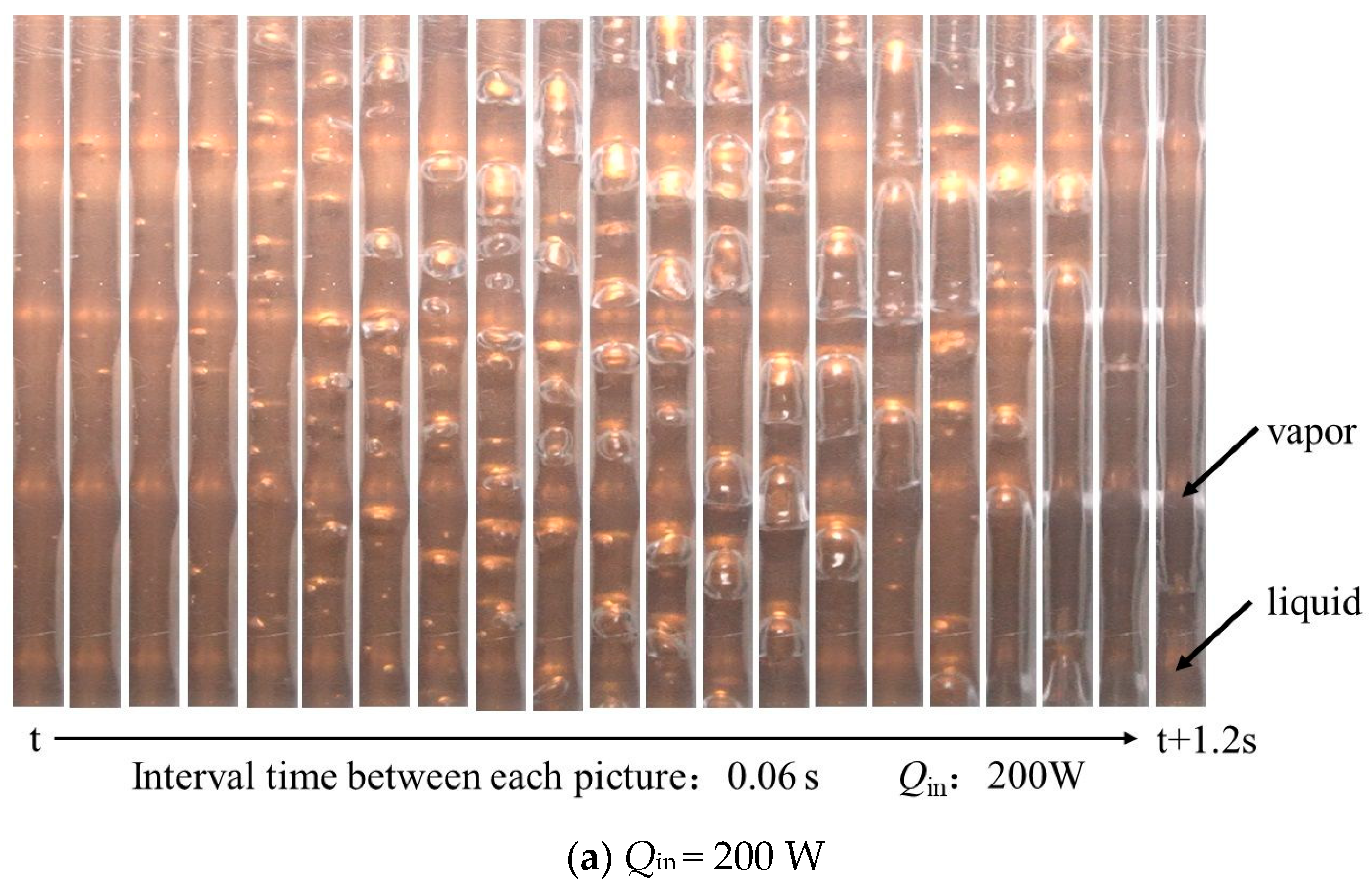

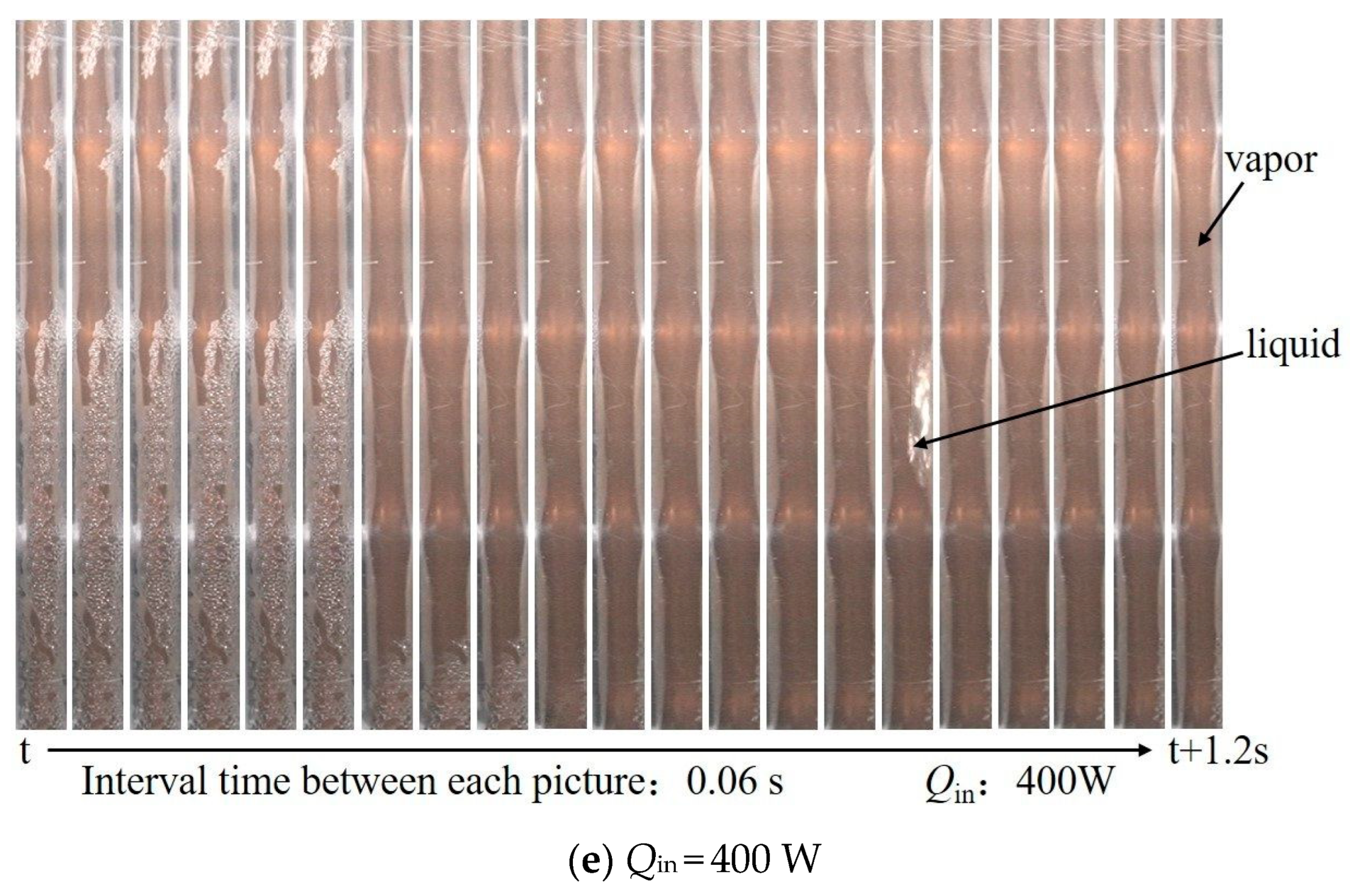
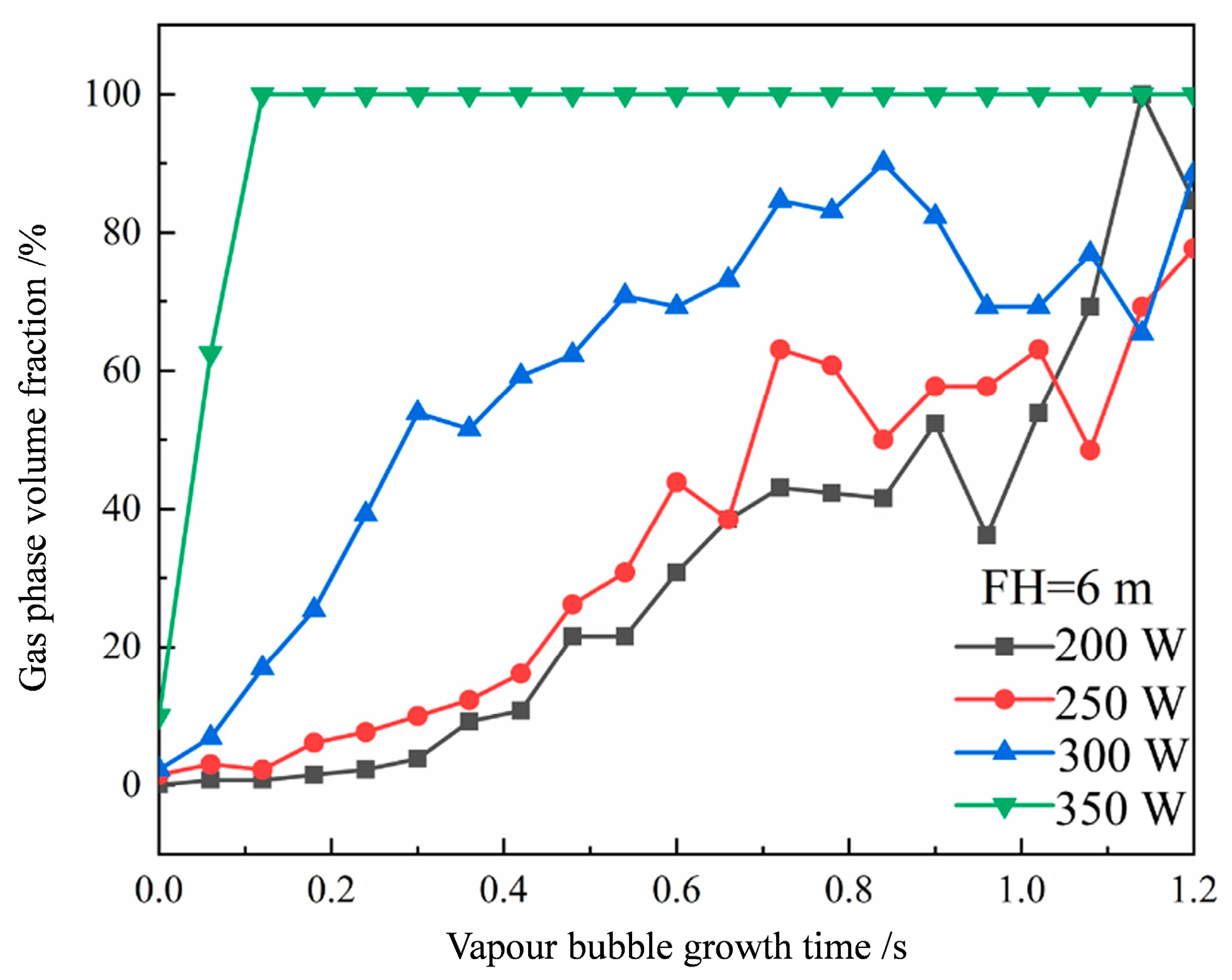
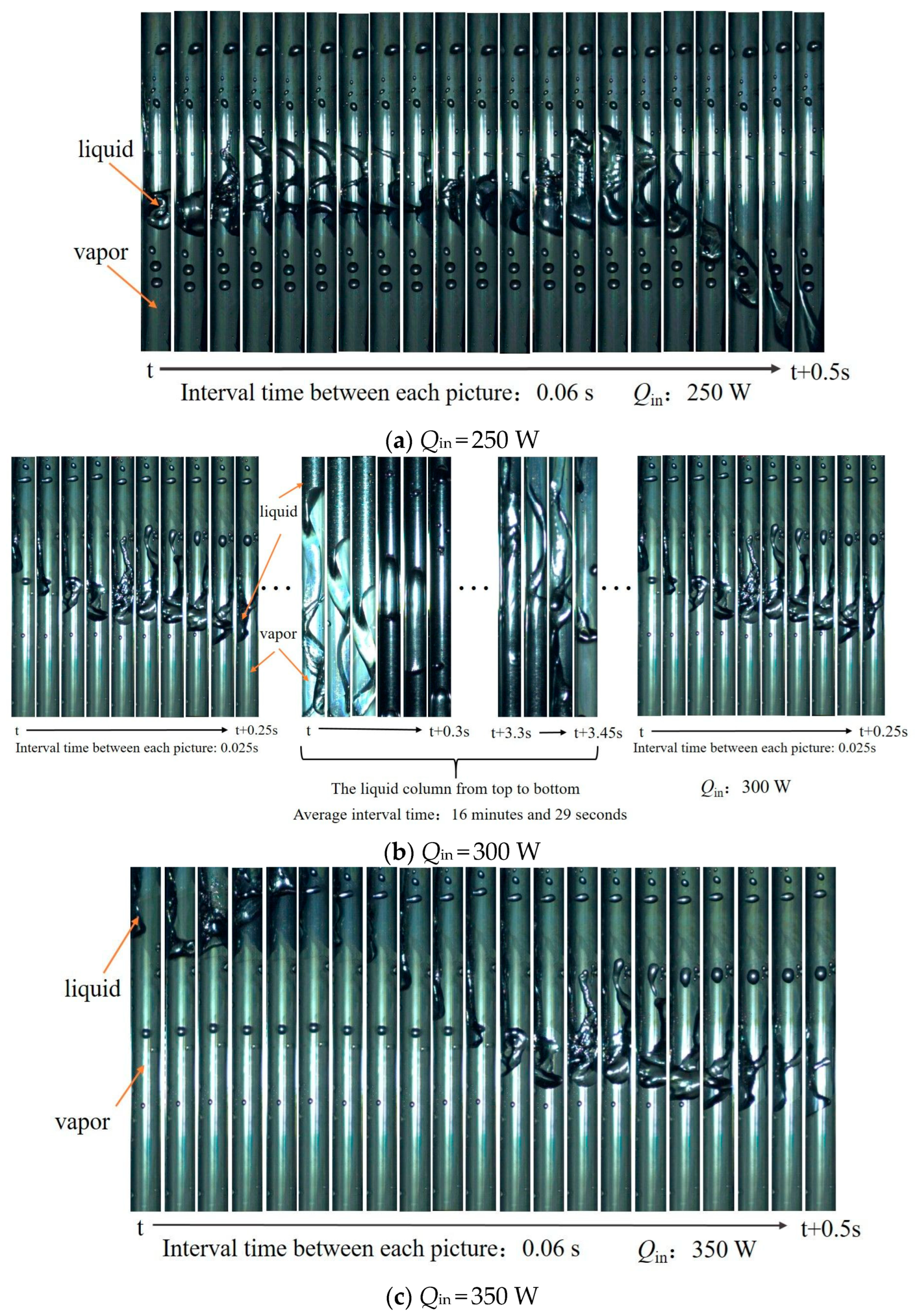
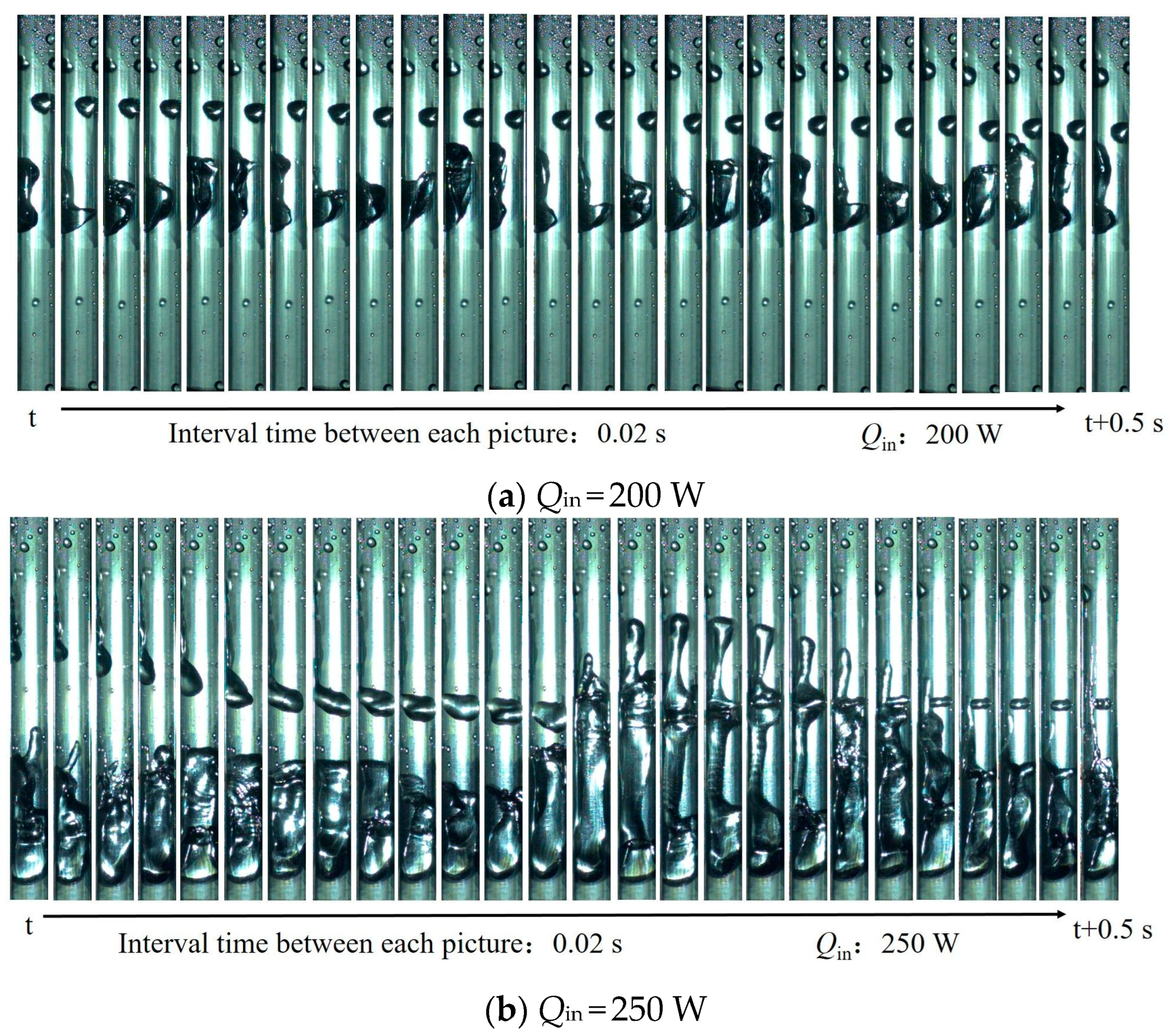
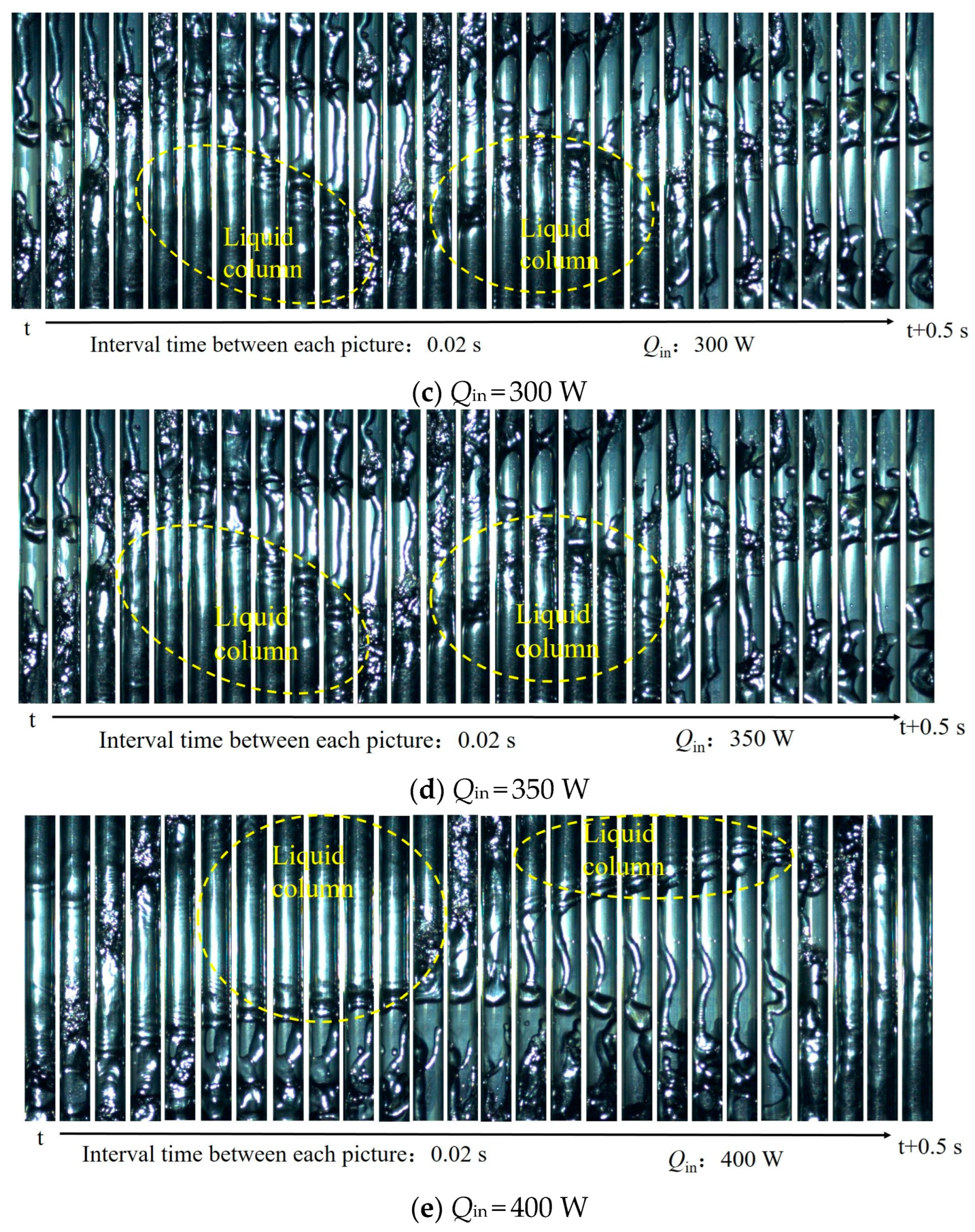
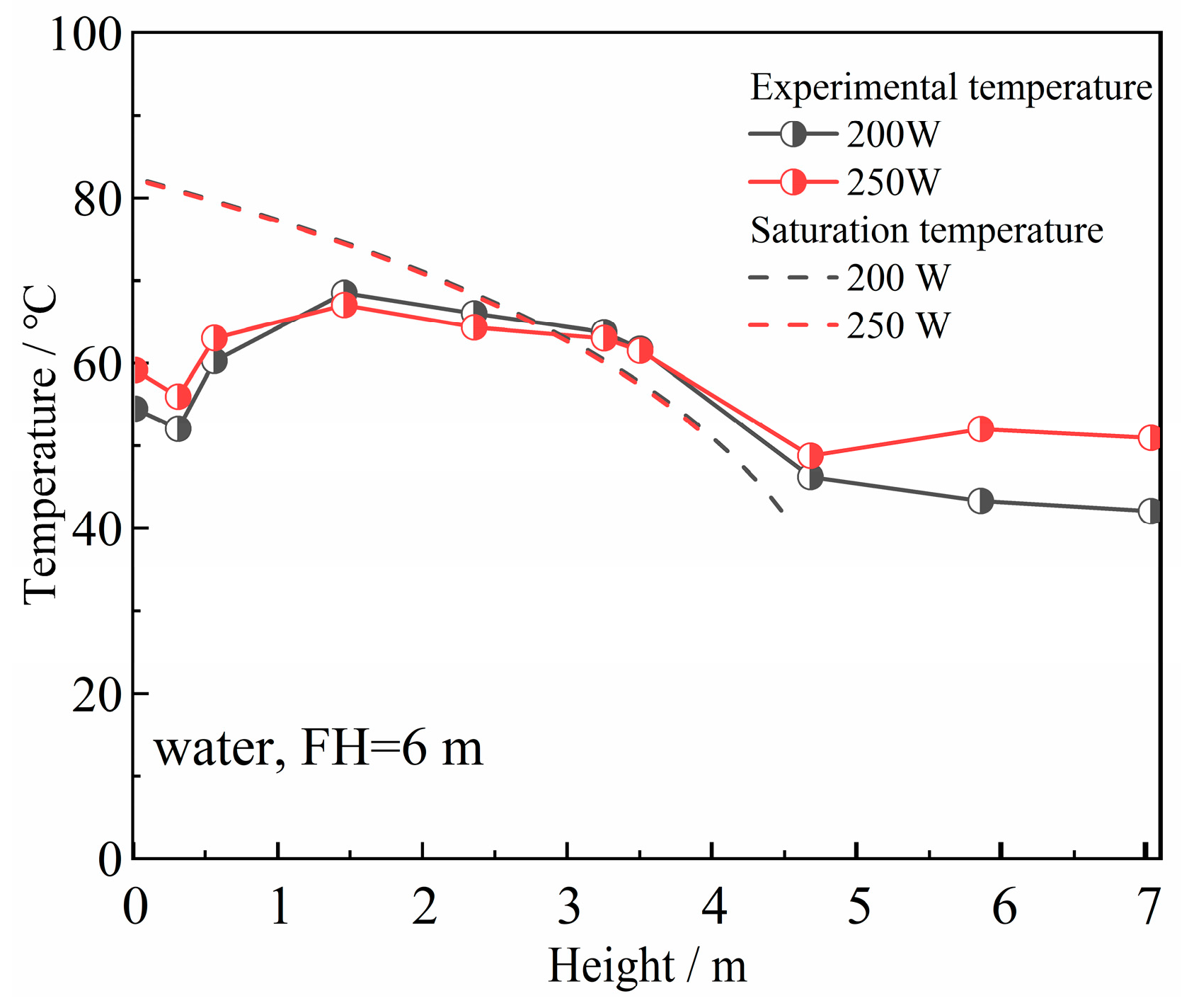
Disclaimer/Publisher’s Note: The statements, opinions and data contained in all publications are solely those of the individual author(s) and contributor(s) and not of MDPI and/or the editor(s). MDPI and/or the editor(s) disclaim responsibility for any injury to people or property resulting from any ideas, methods, instructions or products referred to in the content. |
© 2023 by the authors. Licensee MDPI, Basel, Switzerland. This article is an open access article distributed under the terms and conditions of the Creative Commons Attribution (CC BY) license (https://creativecommons.org/licenses/by/4.0/).
Share and Cite
Li, F.; Chen, J.; Cen, J.; Huang, W.; Li, Z.; Ma, Q.; Jiang, F. Two-Phase Flow Visualization and Heat Transfer Characteristics Analysis in Ultra-Long Gravity Heat Pipe. Energies 2023, 16, 4709. https://doi.org/10.3390/en16124709
Li F, Chen J, Cen J, Huang W, Li Z, Ma Q, Jiang F. Two-Phase Flow Visualization and Heat Transfer Characteristics Analysis in Ultra-Long Gravity Heat Pipe. Energies. 2023; 16(12):4709. https://doi.org/10.3390/en16124709
Chicago/Turabian StyleLi, Feng, Juanwen Chen, Jiwen Cen, Wenbo Huang, Zhibin Li, Qingshan Ma, and Fangming Jiang. 2023. "Two-Phase Flow Visualization and Heat Transfer Characteristics Analysis in Ultra-Long Gravity Heat Pipe" Energies 16, no. 12: 4709. https://doi.org/10.3390/en16124709
APA StyleLi, F., Chen, J., Cen, J., Huang, W., Li, Z., Ma, Q., & Jiang, F. (2023). Two-Phase Flow Visualization and Heat Transfer Characteristics Analysis in Ultra-Long Gravity Heat Pipe. Energies, 16(12), 4709. https://doi.org/10.3390/en16124709








